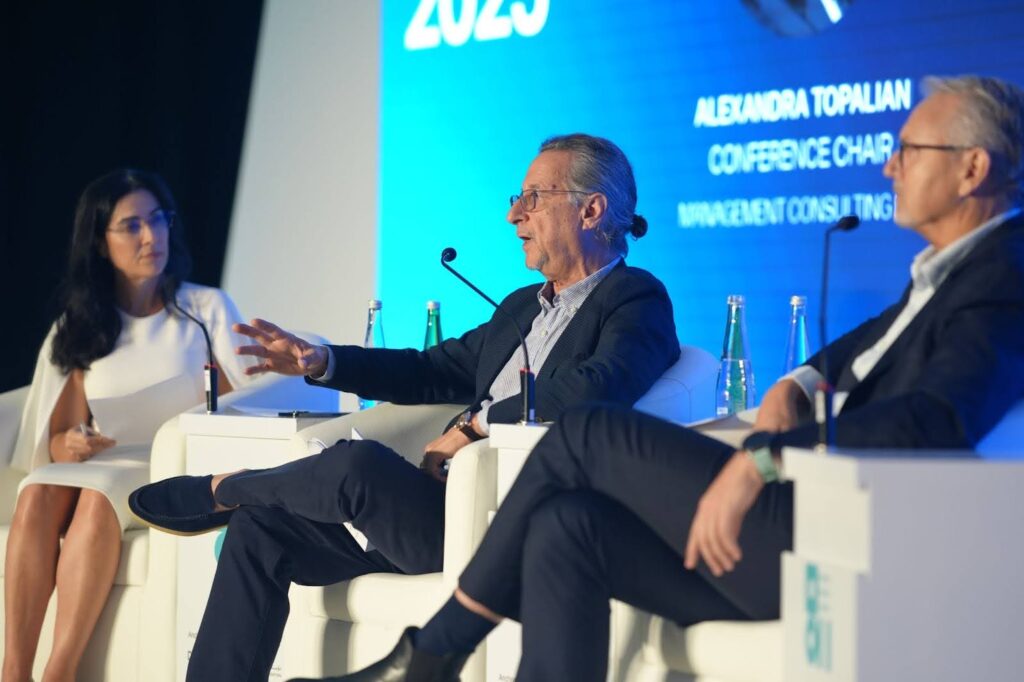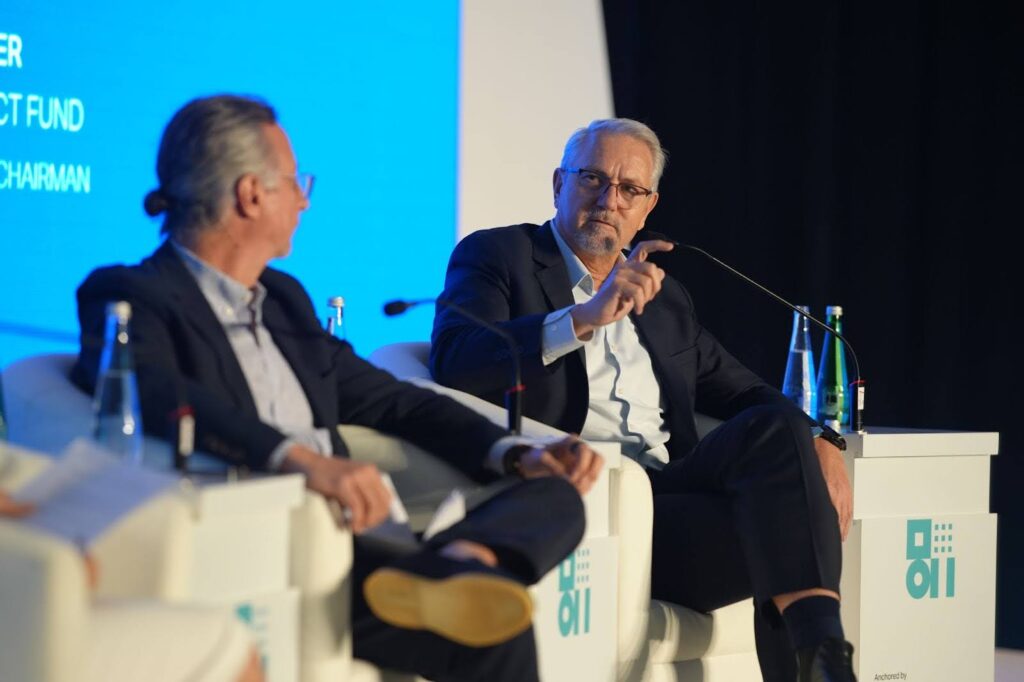At our 2025 AGM, we held a panel conversation to explore how global forces are shaping DFDF’s investment outlook — and how we, as a government-backed platform, are preparing to navigate and lead through the shifts ahead.
The panel was moderated by Alexandra Topalian and featured:
- Ziad Makkawi, Founder of Equiam and Member of DFDF’s Investment Committee
- Jacques Visser, Chairman of DFDF’s Investment Committee
Together, the panelists explored the AI revolution, the rise of secondaries, and the emergence of systematic, data-driven investing.
Riding the AI Wave Without Losing Ground
There’s no denying that artificial intelligence is dominating headlines, funding rounds, and global VC attention. But it’s not just about hype — the performance metrics speak for themselves. AI-native companies are reaching hundreds of millions of dollars in revenue within months, a milestone that traditionally took seven years for top SaaS players. Comparatively, their revenue per employee is 15-25x that of traditional peers.
As the panel put it, we’re witnessing a transformation so sweeping that if you’re not integrating AI as a fund, you’re not going to survive.
A Regional Response Rooted in Realism
While the AI frenzy is global, the MENA region is experiencing it on its own terms. We see AI embedded into nearly every new startup registering in DIFC. However, true deep-tech investment opportunities in the region remain limited. Local GPs aren’t yet structured or resourced to underwrite advanced AI plays at scale — and that’s not unique to MENA. Even in the U.S., investors are struggling to keep pace with AI’s velocity.
That’s where DFDF sees an opportunity to act as a bridge. By investing globally into GPs with demonstrated AI expertise, we gain access to innovation pipelines. We then mine their portfolios for relevant use cases and, together with them, bring those companies into the region—where the companies can grow with government support, receive investment opportunities, and leverage local partnerships connections. It’s a bottom-up approach, rooted in strategic relevance.
Beyond capital, we recognize our role in shaping the enabling environment. That includes facilitating access to data pools, pushing for clearer regulatory frameworks, and complimenting the set up of sandboxes where startups can build, iterate, and scale responsibly.

Private Markets Are the New Public Markets
The second major trend shaping our thinking is the transformation of private markets. The number of unicorns in the U.S. has grown from a couple of hundred to over 800+ in the past decade. These companies are staying private longer, raising larger rounds, and reaching valuations north of $300 billion before ever touching a public listing.
This shift has made liquidity a central concern, especially with IPO windows mostly closed since 2022. The rise of direct secondaries is addressing this gap, offering earlier exits for investors and injecting much-needed transparency into a traditionally opaque asset class.
We see secondaries not just as a liquidity tool, but as an on-ramp for broader democratization of private equity. Institutional capital is already shifting. Major U.S. endowments like Harvard and Stanford now allocate the majority of their portfolios to alternatives. Regulatory changes are opening up access to 401(k)-type investors.
For us, this raises an exciting question: can Dubai become a regional (or global) secondary market hub?

Building for Liquidity at Home
In the middle east region, we’re still early in the private markets cycle. Most activity has historically focused on early-stage, pre-seed, and seed investments. Later-stage capital has been scarce, and that’s a gap we’re now aiming to close.
At DFDF, we see it as our role to plug the capital holes that arise when companies mature beyond the seed stage but still lack access to structured growth or secondary funding. We’re looking closely at late-stage investments and secondary participation as pathways to provide founders and early investors with liquidity options.
But we also acknowledge that structural evolution is needed. The region lacks the regulatory readiness and market infrastructure to support true secondaries at scale. That’s why we’re working with government stakeholders to help define and enable these pathways. Whether it’s policy reform, investor education, or co-creating new secondary platforms, we know this is a long game—and we’re committed to being a part of it.
Entering the Era of Systematic Venture
The convergence of data availability, compute power, and AI isn’t just transforming startups. It’s also changing how investment firms themselves operate.
Just as the 1980s saw public markets transformed by the rise of systematic, data-driven funds (think Bridgewater, AQR, or DE Shaw), we are now entering a new era of “systematic VC.”
Today, every private transaction generates data exhaust: valuations, investor profiles, round sizes, timing, and more. For DFDF, this matters in three ways:
- Elevating the ecosystem: By partnering with global data-driven VCs, we can bring their frameworks into our region and equip local GPs with tools to make more disciplined, data-backed decisions.
- Improving governance and reporting: We’re committed to introducing stricter reporting standards across our portfolio, pushing for consistent financial disclosures and performance tracking.
- Shaping policy: We’re exploring how Dubai can require more transparent reporting from private companies, much like India or the UK already does.
Transparency isn’t just good governance. It’s a precondition for data-rich, scalable capital markets.

What’s Next for DFDF
This panel discussion made clear that DFDF isn’t simply reacting to global headwinds. We’re leaning in with intention.
Our next phase includes:
- Deepening our fund-of-funds strategy to gain exposure to advanced sectors and bring proven global models to MENA.
- Working with GP portfolios to identify startups with strategic relevance to Dubai’s economic agenda.
- Creating onramps for later-stage investment and secondaries.
- Advocating for regulatory change and enabling infrastructure around data access, liquidity, and digital market platforms.
- Serving as a connector between government priorities and global capital trends.
Whether it’s AI enablement, liquidity innovation, or systematic investing, we know the pace of change is only accelerating. Our job is to ensure the MENA region isn’t just keeping up, it’s helping to lead.

